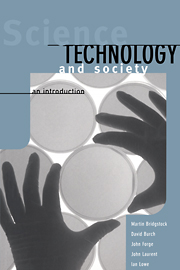Book contents
- Frontmatter
- Contents
- List of Figures
- List of Tables
- List of Contributors
- Preface
- Part One Scientific and Technological Communities
- Part Two Scientists and Technologists in the Wider Society
- 6 The Industrial Revolution in Great Britain
- 7 Science, Technology and the Economy
- 8 Science, Technology and Economic Theory
- 9 Science, Technology and Public Policy
- 10 Science, Technology and the Less-developed Countries
- 11 Science, Technology and the Future
- Appendix 1 Surviving in the Information Jungle
- Appendix 2 Referencing
- Index
11 - Science, Technology and the Future
Published online by Cambridge University Press: 04 February 2010
- Frontmatter
- Contents
- List of Figures
- List of Tables
- List of Contributors
- Preface
- Part One Scientific and Technological Communities
- Part Two Scientists and Technologists in the Wider Society
- 6 The Industrial Revolution in Great Britain
- 7 Science, Technology and the Economy
- 8 Science, Technology and Economic Theory
- 9 Science, Technology and Public Policy
- 10 Science, Technology and the Less-developed Countries
- 11 Science, Technology and the Future
- Appendix 1 Surviving in the Information Jungle
- Appendix 2 Referencing
- Index
Summary
The world of today is undergoing rapid changes, many of them driven by advances in science and technology. Our world has been shaped dramatically by new technology. Think of the impact of the car, of television or of the personal computer. Many people see the current rate of change as bewildering, even disorienting. There is no reason to suppose that the pace of change will ease. Indeed, there are two reasons for expecting change to be more rapid in the future. More scientists are working today than ever before, so the pace of scientific advance is greater than ever (Jones 1982:179–80). Additionally, the power of information technology means that new techniques move much more rapidly from one part of the world to another. So we must expect continued rapid technological change, and associated social, economic and political changes (Kennedy 1993:344–9).
It is a key point that the future is not pre-determined. Many people behave as if it were an unknown land which we discover one day at a time. Just as the world of today has been shaped by the decisions and actions of our forebears, the future is being formed all the time by what we do, what we say and what we think. Japan has changed in forty years from a middle-rank economic power with a reputation for shoddy workmanship to the world's dominant economy with a reputation for excellent design and quality manufacture (Kennedy 1993:150–4).
- Type
- Chapter
- Information
- Science, Technology and SocietyAn Introduction, pp. 232 - 256Publisher: Cambridge University PressPrint publication year: 1998



